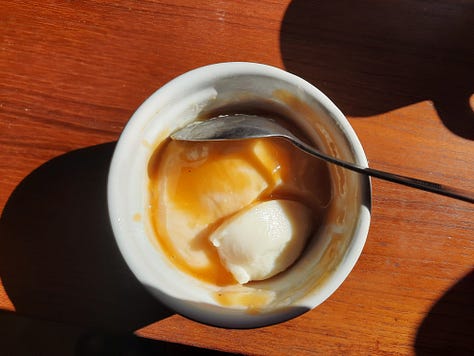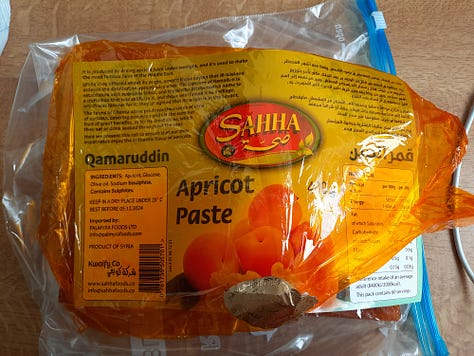82. Milky, fragrant and tart set puddings
No gelatin required. Plus we're learning about the significance of a Syrian/Lebanese apricot fruit leather known as Ammardeen!
Tart Lime Posset, with or without blackberry sauce
America’s Test Kitchen describes posset as ‘the easiest dessert’ to make. I’m always up for simple, easy treats so it’s surprising that I hadn’t made it before. It dates back to the 1500s, apparently, but in its current format to the late 19th century. Possets are mentioned in both Shakespeare’s Macbeth and The Silver Chair by C.S. Lewis.
Lemon is more traditional but lime is equally lovely.
The posset is perfect on its own, but I’ve included the blackberry sauce I’ve made here in case you’d like to try it. Other things that would be nice instead: a handful of blueberries, a plain buttery biscuit or square of dark chocolate.
Don’t serve much sauce with the posset, if any - too much will overly loosen its silky, just-set texture.
Lime Posset recipe
To serve 4 — this scales up or down easily if you want to make less or more
400ml/g double/ heavy cream
100g sugar
90g lime juice (approx 6 limes, or 6 tbsp)
Zest of 2 limes
Heat the sugar and cream together gently until the sugar dissolves in the cream, stirring occasionally. Turn the heat up and boil vigorously but carefully for 2 1/2 minutes, stirring continuously.
Stir in the lime zest and juice. Divide between 4 serving cups/glasses. Chill for at least 2 hours - until set - or up to overnight.
Keeps for 2-3 days, covered in the fridge.
Blackberry sauce
300g blackberries
1/2 tbsp / 8g lime juice
150 g sugar
Cook gently until the sugar has dissolved, then simmer until it reaches 102-105C / 216-221F or until you have the texture you desire. If you want it to reduce more, simmer gently, stirring now and then to prevent it sticking to the bottom, until it’s the right consistency for you.
Muhallabieh, with or without apricot fruit leather sauce



Muhallabieh, ksab, sutlaj, saleb and malabi are all names for milk puddings or milky drinks found in the Middle East. We don’t really have an equivalent in the West - the closest thing we have is creme patissiere - but this is even more set and more delicately flavoured, with no egg yolks in sight. At first you might find it unusual, even challenging on the palate (I found the texture a bit odd at first), but it’s very refreshing, when served cold like this.
Traditionally the puddings and drinks are thickened with saleb/sahlepi, a delicious orchid root, which is endangered in the wild and very expensive these days. So cornflour and rice flour have stepped in to fill the void.
In London, you can still get salep ice cream from Iranian groceries (no idea if they use real salep but it’s possible), or from certain ice cream parlours, such as Soho Creamery.
Muhallabieh - Middle Eastern Milk Pudding
Serves 4-6
50g cornflour/ cornstarch
700ml whole / full-fat milk
80g sugar
Orange blossom water, to taste (I used 1/2 tsp as mine is strong)
Other things you could use to flavour instead: you could infuse the milk with cardamom, vanilla, bay leaves or add a citrus zest instead of the orange blossom
Serving options:
A fruit compote (see apricot option below)
A nice syrup. Maple, palm syrup, a light honey, grape petimezi/pekmez (molasses) or date petimezi/pekmez (molasses) would all be nice options
Chopped pistachios or walnuts
Fresh fruit - a nice berry for example
Whisk the cornflour with 100ml of the milk until you achieve a smooth, evenly textured paste.
Gently heat the rest of the milk (and any whole spices you’re infusing) with the sugar until the sugar dissolves. When it starts to steam, add the cornflour slurry. Keep the heat on and continuously whisk until it thickens, looking like a thick custard. Stir in the orange blossom, if using. Pour into 4-6 cups or glasses, plucking out any whole spices as needed. Cover the surface of each with cling film and refrigerate for at least 3 hours, until set and cold.
Serve each portion with about a tablespoon of sauce or syrup, or even less. Too much will overpower the delicate flavour and unique texture of the milk pudding.
Ammardeen (Apricot Fruit Leather) Sauce
You can only buy large amounts of this stuff at a time, if you are lucky enough to find a source for it. Luckily it tastes incredible and is a wonderful chewy snack on its own, albeit a workout for your molars. Its acidity balances the sweetness well. The apricots I seem to buy fresh are quite bland. Fresh apricots do have a delicate flavour - bur I’m sure this is partly because they’re just not very good. But this fruit leather tastes very strongly of apricot, which is lovely.
Like some other sweet treats we’ve covered before - such as dates, ma’amoul and the Manchester (England) made drink Vimto - it’s commonly eaten during Ramadan, when a small bit of something sweet to break fast may help one’s energy levels as well as being in line with the practices of the Prophet عَلَيْهِ ٱلصَّلَاةُ وَٱلسَّلَامُ .
100g ammardeen (sun-dried apricot fruit leather from Syria)
100g hot water
Rip up the amardeen, or cut it up with clean kitchen scissors. It’s too chewy for a knife to be the most helpful implement here. Soak the ammardeen in the hot water for a few minutes. Blitz with an immersion blender, or a high-powered blender. Refrigerate until cold.
If you wanted to take this a step further, making a sort of jelly/pudding instead, there are plenty of recipes online that call for you to reduce it and thicken it with a cornflour slurry, much like we did with our muhallabieh.
Fruit Roll-Ups started with Ammardeen, and some other points of interest
I loved reading this article about the Lebanese-American Shalhoub family and development of fruit roll-ups.
Ammardeen is most often not served as is but made into a juice drink called Qammar al Din, which means ‘moon of the religion’ - though the name might come from a person rather than some special religious significance. Sometimes rosewater or orange blossom water is added. Often a large amount is made in advance to serve a group all breaking fast together.
In Iran a similar product called lavāshak is made, generally with apricots or plums but sometimes with cherries. It’s usually served as a thinner fruit roll.
It is enjoyed in Arab north and east African countries as well as in the Arab peninsula.
It’s often drunk alongside a cup of milk and a date when breaking fast.
It’s generally made with a particular variety of apricots found in the Ghouta region of Syria.
Water, sugar and apricots are heated then passed through a sieve, then dried out in the sun.
This video gives some idea of the scale of production - it’s epic!
Apricot kernels are taken out during the process but then exported to make popular products in other countries. Despite being extremely toxic, apricot kernels are incredibly delicious, and used in loads of biscuits in Europe. Just don’t eat too much of them!!
It’s common in Syria to eat a small bit of ammardeen as a snack, wrapped around a walnut. I can confirm that this is delicious!





